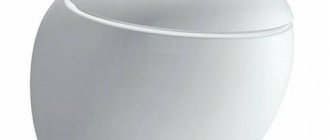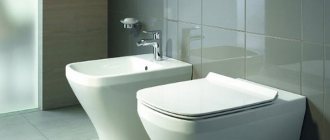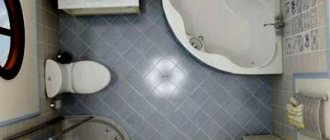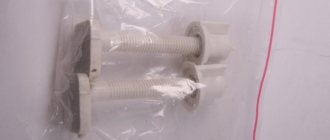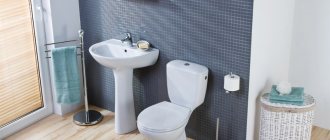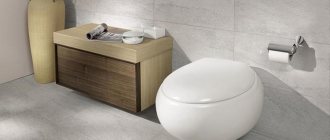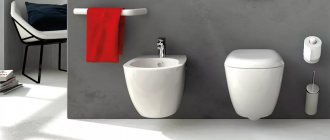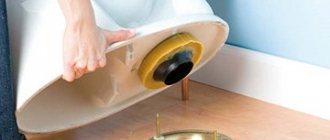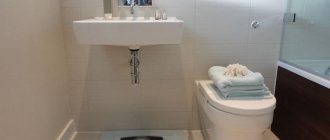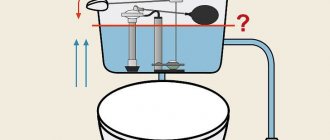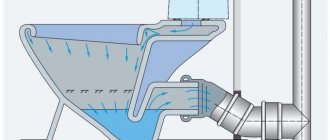In total, a person spends about hours of his life in the toilet. I think this is a serious argument in favor of taking the arrangement of this modest-sized room very seriously. Today we will tell you not only how to choose the right toilet, but also present the most popular models so that you make the only right choice.
The supply of sanitary ware for toilets on the market reflects the established demand for it as clearly as possible. If a person can do without expensive tiles and suspended ceilings in his bathroom, then he cannot do without a toilet. People's appetites vary, but the set of criteria that determine which toilet is best to choose remains unchanged.
So, first of all, let's consider the choice of material from which the toilet is made.
Materials
Sanitary Ware
Perhaps the most common material, which is based on fine-pored white ceramics, coated with enamel of one color or another. Compared to other materials, sanitaryware is relatively cheap, and this is the reason for its overall popularity. Like any material of this class, sanitary ware has its drawbacks. The main one is the high abrasion of the enamel, which leads to the penetration of moisture into the very structure of the ceramics. As a result, the strength of the product slowly but surely decreases. And then until the bowl is completely destroyed not far away, especially if you or your relatives are quite impressive in size.
Porcelain
In appearance, many people confuse this material with earthenware, but the price of toilet bowls puts everything in its place: porcelain is based on the same white clay, but during manufacturing it is diluted with feldspar and quartz and acquires more solid technical characteristics. Accordingly, the enamel that covers clay, does not wear out so quickly, and pleases the happy owners of porcelain toilets with a rich color for quite a long time. Not for the rest of their lives, of course, but about twice as long as a sanitary ware toilet. However, you need to pay well for good porcelain: its price is higher in comparison with the above-mentioned earthenware products by about 40-45%.
Stainless steel
A less popular material, but much more durable and durable. Toilets made of steel are absolutely not afraid of moisture and, due to their durability, are excellent for public spaces. Even if some vandal wants to mock the steel “white friend,” he is unlikely to succeed. For an unlimited warranty period of use, you have to pay accordingly - steel toilets are more expensive than even porcelain products.
Cast iron
Have you ever seen cast iron toilets? Surely not, but this is not surprising: they are very rarely offered for sale in ordinary plumbing stores. The explanation for the market’s dislike for this material lies on the surface: cast iron toilets are very heavy and unreasonably bulky. These disadvantages cannot be overcome even by the resistance of cast iron to corrosion and rust.
Marble, artificial stone
One of the most expensive materials for toilets, which is in demand primarily among those who welcome the unique design of the room and have the means to realize their most “kosher” ideas. Toilets made of marble and artificial stone are very hygienic, do not lose color, and are quite economical in terms of water consumption, since bacteria and dirt do not linger on the absolutely smooth surface of the flush area. It is unlikely that you will be able to find such toilets in ordinary plumbing stores - they are usually made to order and have a unique design style.
Plastic toilets
A popular material for bathtubs, acrylic, is also successfully used for the manufacture of toilets. As a rule, such toilets are very light and easy to install, but their durability leaves much to be desired. Most often they are used for summer cottages and various auxiliary premises and very rarely at home.
Choosing the material for your toilet is not so bad. The real difficulties arise when it comes to what type of fastening to choose. How to choose a toilet with the most suitable mounting? Read on and note the most popular models.
Connecting plumbing to sewer
Connecting the toilet to the sewer pipe - this moment in the work seems very difficult to many and most often because of it, the installation and connection of the toilet to the communications is entrusted to plumbers. In reality, everything is not so complicated. The instructions that will be offered to you below will help you successfully perform the necessary actions:
Installing a cistern on a toilet
- Before dismantling the old toilet, study in detail the features of its connection to the sewer system. Similarly, you will connect new plumbing.
- In cases where it is not possible to directly connect the toilet outlet to the sewer pipe, use a special corrugated pipe. When choosing it, give preference to the most durable material, as it tends to wear out. Plumbers say this is a temporary solution. But by choosing the thickest corrugated pipe, you can be sure that it will serve you for a long time.
- Turn off the water before starting work.
- Use sealants to seal pipe joints.
After you have made the connections to the sewer yourself, you need to install a tank to drain the water.
Fastening
Floor standing toilet
Perhaps the most common toilet bowls, which are equally often found both at home and in various kinds of public buildings. The delivery set includes anchor bolts and clamping nuts, with the help of which the bowl is firmly fixed in place. The ease of installation captivates buyers and encourages them to equip their bathrooms with toilets of this particular type.
There are two types of floor-standing toilet designs:
- compact
- monoblock
The first option is the most popular: separating the bowl and tank makes it easy to replace one or another part in case of breakdown or choose a unique design solution. True, only if the store sells bowls, seats and tanks separately, and not together, as is most often the case.
The monoblock is a single design. This fact significantly limits the repairability of one of the leaked parts of the toilet. But toilets with a single design are cheaper than compact ones - if you are extremely limited in funds, then it makes sense to save, don’t you think?
One of the most popular models of floor-standing toilets on the Russian market is JIKA Lyra 8.2423.4.
This is a relatively inexpensive classic compact model, which due to its small size will fit perfectly into the interior of any bathroom. True, it comes without a lid, and the fact that you will have to pay another 800-900 rubles for it can rightly be attributed to the disadvantages of the product.
Other popular models:
Toilet MERIDA M 010 (Cersanit, Poland)
Comfort (Rosa)
Victoria (Roca)
Attached toilet
Many specialized experts do not classify wall-mounted toilets as a separate category, but we will take some liberties, since they still differ significantly in appearance from their classic floor-standing “brothers.” Although the type of fastening remains the same - to the floor, such products have a more massive back that fits tightly against the wall. The tank can be a classic external one or installed in the wall
If you are thinking about how to choose a toilet for your home, but prefer large bowls, then this type of toilet is your best choice. With only one caveat - if the size of the room allows you to painlessly fit such a hulk into it. Otherwise, it is better to pay attention to smaller toilets.
A well-known model of this type is VitrA S50.
A very colorful and expressive toilet that looks like a real giant. It impresses with its massive appearance and has the remarkable ability to make any bathroom richer and more spectacular. At the same time, it is not as expensive as one might think - 4,000-45,000 rubles.
Other wall mounted toilets:
Roca Meridian
Wall-hung toilet
Practical and compact type of toilets. This allows them to be used even in the most modest-sized rooms, while saving precious centimeters. They look minimalistic and very modern, but require more complex installation compared to other types of toilets due to the use of an installation system.
The frame with the tank is attached to the floor and walls and then covered with gypsum board. The flush control is carried out using a button placed outside. Sound insulation is on your side - now the neighbors can only guess about your manipulations in the bathroom. On your side is the possible failure of the installation frame. It will not be possible to easily fix a breakdown, unlike the above types of toilets, so it is better to look only at high-quality models of wall-hung toilets with installation.
Many people are quite skeptical about this type of installation, questioning the frame’s ability to withstand a more or less significant load. And it’s completely in vain - some models of wall-hung toilets with installation are designed for a load of more than four hundred kilograms! Impressive? Well, then prepare your money: such systems cost a little more than conventional floor-mounted or wall-mounted toilets.
The popular model of the wall-hung toilet Roca The Gap, which represents a reasonable combination of price and quality.
It does not take up much space, has a non-standard shape, and amazes the eye with its emphasized geometric harmony and slightly smoothed corners.
Other popular models:
Roca Dama Senso
Vitra MOD
Cersanit DELFI Leon
Visa 8050
Roca N-Meridian
Corner toilets differ from floor-standing ones only in their placement in the bathroom. The type of fastening remains the same
For those who are persistently looking for an answer to the question of which toilet to choose, it will be useful to know about the outlet through which, in fact, your “white friend” interacts with the sewer. Many buyers of toilets do not even suspect that they may differ from each other.
Dimensions and dimensions
For the dimensions of a floor-standing toilet, as well as for other parameters during construction and repair, there is a GOST, according to which the following types of devices are distinguished (H×L×W):
- Children's toilets - 335 x 405 x 290 mm;
- Adults, without solid cast shelf – 400 x 460 x 360 mm;
- Adults, with a solid cast shelf - 370 x 605 x 340 mm.
As for floor-standing toilets, their dimensions vary somewhat, depending on the modification. Thus, compact toilets are small - 380x800x675 mm. Corner models have a specific shape, and therefore their dimensions are not standard - 360x815x760mm.
Photos of popular models of floor-standing toilets
Ceramica Ala Today
Nido Yxbw01 Hatria
Villeroy&Boch Architectura 5687
JACOB DELAFON Escale EU19038W
Kerasan Flo 3117
Release
So, there is a horizontal sewer outlet. The sewage system is drained from the wall. This is the most common issue in city apartments. An example of it is shown in the following photo.
There is also a vertical one . Here the drain is removed from the floor; it is more typical for country cottages and private houses. Its character is clearly visible in the photo.
Self-installation of the cistern
In standard compact toilets, the flush cistern is mounted on the toilet shelf. After its installation, the structure is one piece with the toilet. Before you start working, prepare everything you need: internal fittings of the tank; sealing gasket; flexible hose for connection to the water supply; mounting bolts, nuts, rubber gaskets (all this comes with the drain tank). Now let's get down to action:
- Attach the sealing gasket to the toilet shelf (most often, it is self-adhesive) between the main parts of the kit.
- Install the drain tank on it, secure it with bolts.
- Use a flexible hose to connect it to a cold water pipe. Do not forget about sealing when connecting to the water supply.
- After this, turn on the water and test the drain tank. If the drainage system is functioning and no water is leaking, then you are done.
It is quite possible to do the installation and connection of the drain tank to the water supply yourself, even without being a specialist. And by choosing modern plumbing, you will have the opportunity to get maximum comfort at an affordable price. Repair is not a natural disaster, it is a change for the better. With the right approach, you can do it yourself and with sufficient quality.
Water supply
There are toilets with bottom and side inlet. Which is better?
Pay attention to the bottom one - models with such an inlet are distinguished by almost silent filling, and the hose itself is not very visible.
But toilets with side water supply are cheaper. What is more important - material gain or little things of comfort? You will have to think about this dilemma more than once when choosing a toilet for your bathroom.
Flush type
When thinking about which toilet is better to choose, many people rightly pay attention to the type of fastening, sewer outlet and completely lose sight of the flush system installed in a particular model.
Perhaps the most famous option is direct flush . It is often called differently - cascade, horizontal , but don’t let this fool you - this is still the same widespread (since the times of the Soviet Union) flushing system, in which the water has a straight flow path and descends evenly along the wall of the bowl to the bottom drain.
Young people scold this type of flushing, and rightly so: the fact is that it has outlived its usefulness. During such a descent, the inner surfaces of the bowl remain untouched, which allows impurities and, of course, bacteria to accumulate there.
But every cloud has a silver lining - direct flushing allows the water flow to gain a pronounced intensity and purification along the flushing path is almost 100%.
The basis of a circular flush, or, as it is also called, a reverse-circular flush, is a completely different water supply system: it moves along a ring-shaped gutter and methodically washes the entire area of the thicket.
Young people really like this kind of flushing system, because with it you don’t need to use a brush for a long time - the flow of water reaches the most difficult areas of the bowl. True, in particularly difficult cases you will still have to pick up an auxiliary tool: due to the annular trajectory, the flow loses some pressure and some impurities may remain noticeable. But this already depends on the shape of the bowl, which we will talk about below.
As a rule, toilets with a circular flush system are more expensive. Recently, there has been a tendency to replace the technically outdated direct flush with a circular one.
Apparently, this is justified by time, right?
Additional functions
Photo: Rimless design
The equipment may contain various additional options that facilitate the maintenance procedure and provide increased convenience during operation:
- Rimless models are a godsend for those who are worried about maintaining cleanliness under the rim of the unit. The solution does not require special cleaning;
- Anti-splash system - allows you to compensate for the appearance of splashes thanks to the presence of a funnel-shaped flushing system with flat sides. To solve the problem of splashing, toilets with a shelf, which are also known as pan toilets, can be used. But these models are characterized by less hygiene and require greater fluid consumption for flushing;
- Bidet function – available in the bidet toilet modification, which is equipped with a pull-out spout, providing convenient organization of personal hygiene without installing a separate unit;
- Microlift - thanks to the presence of a special mechanism, a toilet with a microlift smoothly lowers the lid, preventing falls, cracks and reducing the overall noise level.
Photo: Microlift function
These recommendations will be a good help in choosing the optimal toilet model that will meet the technical requirements and ensure ease of use for all family members.
Bowl shape
From the flush to the bowl shape. This is also very important if you want to choose the right toilet. If the shape of the bowl is incorrectly selected, even the smoothest working circular flush may not cope with the task assigned to it.
Funnel-shaped
The most optimal option for the bowl shape, which, due to the drain hole located strictly in the center, ensures quick and good cleaning and, moreover, eliminates the appearance of splashes in the process.
Do you want to forget about what a brush is? Buy a toilet with a funnel-shaped bowl. Disadvantages, of course, can be found for almost any form, but there are none here. The only difference is that such toilets cost a little more, but this is a disadvantage that is easily offset by the pleasure of use.
Disc-shaped
A somewhat controversial solution that requires a larger volume of water for flushing. Human waste products first fall into the recess - and only then, under pressure from the water from the tank, are washed into the hole. Unfortunately, this shape of the bowl contributes to the occurrence of splashes, and the question of saving water remains open. Often it is necessary to additionally adjust the volume of water for flushing. Why such difficulties, you ask? The dish-shaped bowl, however, remains relevant due to the lower price of toilets in which it is present. The most budget models are equipped with it.
Kozyrkovaya
Unlike a plate bowl, this type of bowl does not have a recess in front of the drain, but, on the contrary, a protrusion. This allows the bulk of the sewage to go directly into the drain, and the remainder is easily washed out by the pressure of water from the tank. This bowl shape is steadily gaining momentum and is increasingly found even in relatively inexpensive models.
The question of how to choose the right toilet affects not only the shape of the bowl, the type of fastening and all the key points that we discussed above.
Choosing a toilet for your home
To select the necessary modification, the following factors are taken into account:
- Material for production;
- Dimensions of the installation room;
- Water supply option;
- Tank configuration;
- Height and shape of the bowl;
- Flushing method;
- Water consumption parameters;
- Types of toilets;
- Additional options.
Photo: Colored design in Art Nouveau style
When choosing a suitable device, you must take into account the overall parameters of the bathroom and the layout of the room, so that the device does not clutter up the space of the room and does not interfere with free movement. Design parameters, connection possibilities and drain configuration, economical water consumption and compact placement are taken into account. An additional point is the selection of stylistic design, color and options for the comfort of using the unit.
